WBBSE 9th Class Social Science Solutions History Chapter 7 The League of Nations and the United Nations Organisation
WBBSE 9th Class Social Science Solutions History Chapter 7 The League of Nations and the United Nations Organisation
WBBSE 9th Class Social Science Solutions History Chapter 7 The League of Nations and the United Nations Organisation
West Bengal Board 9th History Solutions
WBBSE 9th Class History Solutions
Salient points – At a glance
1. The terrible repercussions of the First World War (1914-18) had a strong impact on the minds of the people and made them cry out for peace. President Woodrow Wilson of America took the initiative and made a plan for the establishment of a world peace organisation known as the League of Nations.
2. The League was established to prevent armed conflicts and to amicably settle international disputes, reduce armaments and achieve international peace and security.
3. Many international issues arose after the First World War. At first, the problems were comparatively easy and the League was able to solve them by peaceful means.
4. The League was too weak to deal with cases which involved the interests of the great powers. Its influence began to decline gradually. The League failed utterly to prevent war and to maintain world peace. The Second World War broke out in 1939.
5. The League of Nations collapsed under the impact of the Second World War (1939-45) and the Allied powers felt the need of a world organisation for peaceful settlement of international disputes.
6. In 1943 at the Moscow Conference, the Big Three (Britain, USA and Soviet Russia) and Kuomintang China were unanimous that an international peace organisation should be set up on the basis of equal status of all members. Representatives of 50 nations met at San Francisco between April and June 1945 and prepared a charter for world peace called UN Charter. On 24 October, 1945 the UNO came into existence.
7. The basic principles of the UNO were: [i] All the members, big and small, in order to enjoy the rights and benefits, would sincerely carry out their duties as per the UNO Charter. [ii] All members shall settle international disputes by peaceful means. [iii] UNO would not interfere in the internal affairs of any county.
8. The membership of the UNO is open to all peace-loving nations of the world which accept the obligations of the UNO and are willing to carry out these obligations. If member countries persistently violate the principles of the Charter they may be expelled by the General Assembly on the recommendation of the Security Council. The Security Council can also restore the rights of a suspended member nation.
TOPIC – A
Foundation and Organisation of the League of Nation
Short Answer (SA) Type Questions
Answer in 2 to 3 sentences
1. How was the League of Nations founded ?
Ans. The terrible repercussion of the First World War (1914-18) made a strong impact on the minds of the people and made them cry out for peace. President Woodrow Wilson of the United States of America took the initiative and made a plan to establish a world peace organisation known as the League of Nations which would solve disputes peacefully. The League of Nations was thus not only an expression of the call to peace, it was also a means of promoting the call to peace.
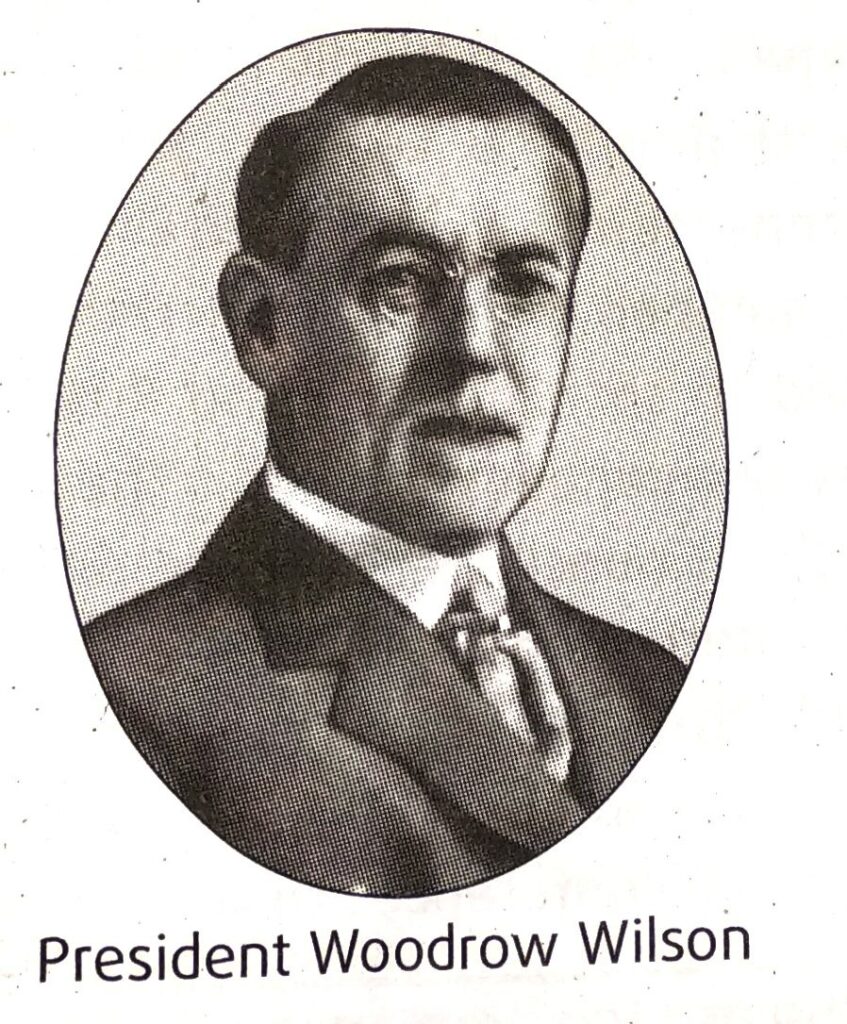
2. With what aim was the League of Nations founded ?
Ans. After the First World War (1914-18) an international peace organisation known as the League of Nations was established in 1920 with the following aims in view: [1] to prevent armed conflict and to promote international peace and cooperation, [2] to establish honourable relations among different nations, [3] to promote international disarmament in order to reduce tension and [4] to find out ways and means for peaceful settlement of international disputes.
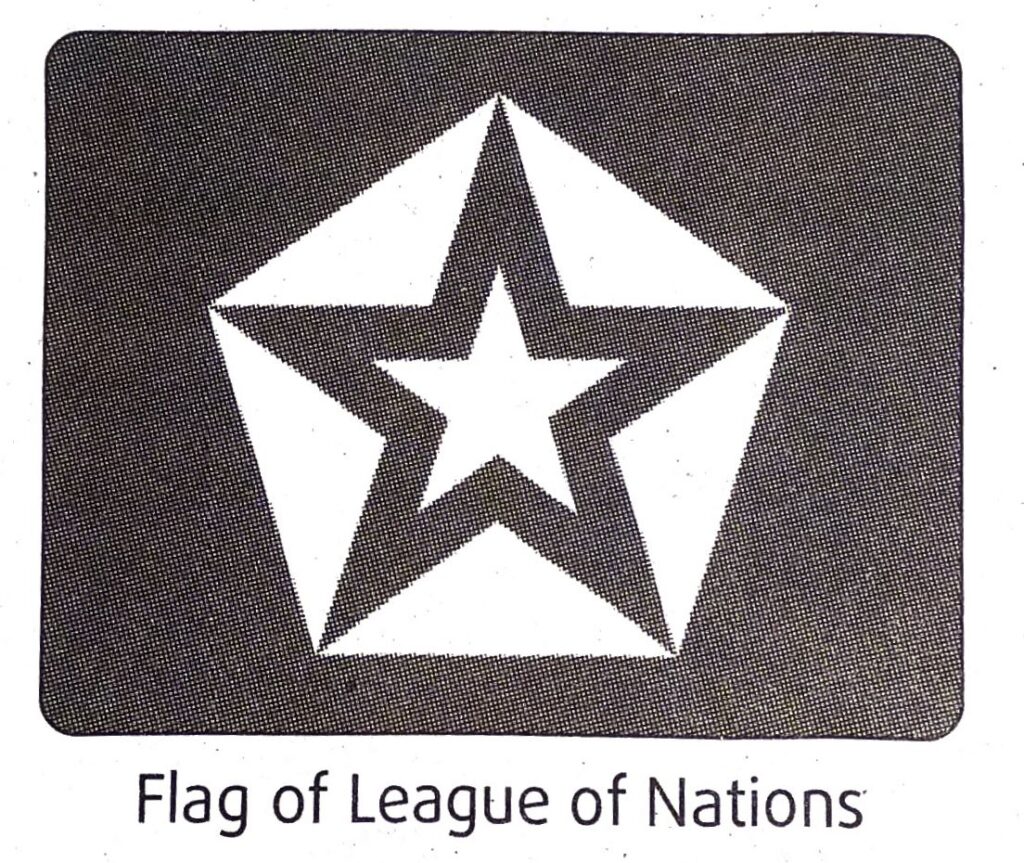
3. Describe the structure of the League of Nations.
Ans. The League of Nations had four main organs, the first of which was the Assembly consisting of representatives of every member state, meeting once a year at Geneva. The second organ was the Council i.e, the executive committee composed of one representative from each of the five permanent states (Great Britain, France, Germany, Italy and Japan) and temporarily of nine other member states, chosen by the Assembly. The third was the permanent Secretariat, located at Geneva the main function of which was to prepare reports for the consideration of the Assembly and the Council. The fourth organ was the Permanent Court of International Justice which was a court of arbitration for the settlement of international disputes with its office at Hague.
Know More
The League of Nations formally came into existence on the same day that the Treaty of Versailles came into operation (10 January, 1920).
4. Write a note on the Covenant of the League of Nations.
Ans. The Constitution of the League of Nations called the Covenant consisted of 26 articles among which the tenth, twelfth and sixteenth articles were of great significance. [1] Under the tenth article of the Covenant, the members of the League of Nations promised to respect the political independence and territorial integrity of the member countries of the League. [2] According to the twelfth article the members unanimously decided to solve their problems through mutual negotiations. [3] The sixteenth article made it clear that if any member country of the League of Nations declared war and violated settlements, that country would be declared the enemy of all nations and her aggression would be faced with all might.
5. Give an account of the General Assembly of the League of Nations.
Ans. The League of Nations functioned through a number of organs, the most important of which was the Assembly. All the states which were the members of the League were essentially the members of the Assembly. Every member state could send three representatives, although no state had more than one vote. The function of the Assembly of the League was: [1] to establish world peace, [2] to resolve international disputes, [3] to extend international security and [4] to work for safeguarding the interests of the minorities.
6. Who were the members of the League Council ?
Ans. The members of the League Council were divided into two divisions: [1] Permanent members and [2] Temporary members. There were five permanent members of the Council, viz, Great Britain, USA, France, Italy and Japan. As United States did not accept the membership of the League of Nations, the number of permanent members remained only four. The number of temporary members were four. Later on the number of permanent members were increased to six and temporary members to nine. Germany and Russia became the new permanent members.
7. Give an account of the Council of the League of Nations.
Ans. The League Council comprised nine members of which five were permanent and four temporary members. The five permanent members were Great Britain, USA, France, Italy and Japan. As USA did not accept the membership of the League, the number of permanent members remained only four. Later on the number of permanent members were increased to six. Germany and Russia became the new permanent members. The function of the League Council were: [1] to discuss about various international disputes and to resolve them, [2] to make efforts to stop war and to reduce armament, [3] summoning of international conferences to resolve disputes.
8. Who are the permanent members of the League Council?
Ans. The Council of the League consisted of four permanent members. Later the number of members were increased to six. England, France, Italy and Japan were permanent members. Later on Russia and Germany were admitted as permanent members.
9. What were the main functions of the League Council ?
Ans. The main functions, of the League Council were: [1] to discuss about various international disputes and to resolve them, [2] to make efforts to stop war and to reduce armaments, [3] summoning of international conferences to resolve disputes.
10. What was the function of the Secretariat of the League of Nations ?
Ans. The function of the Secretariat of the League of Nations were: [1] to list the subjects to be considered in the Assembly, [2] to preserve the documents and necessary papers regarding the minutes of the meetings, settlements and treaties concluded among the member states, [3] to offer necessary suggestions for effecting modifications in the treaties.
11. Mention any two causes of the failure of the League of Nations.
Ans. Two causes for the failure of the League of Nations were: [1] the League was never able to make itself truly ‘representative of the entire world’. Countries like USA, Germany, Russia, Italy and Japan were not members of the League at different stages and no international organisation can be really successful if some of the great powers remain outside of it. [2] The League had no army, navy or air force of its own nor was it in a position to apply economic sanction on the Great Powers which looked after their own interests instead of fulfilling their obligations to the League.
12. Who is known as the ‘Father of the League of Nations? Who was the first of Nati secretary general of the league?
Ans. The US President Woodrow Wilson is known as the ‘Father of the League of Nations’.
The first secretary general of the League of Nations was Eric Drummond.
13. Mention two features of the League of Nations.
Ans. Two features of the League of Nations were: [1] to settle international disputes by peaceful means, [2] to settle all international legal disputes among the members of the league.
Very Short Answer (VSA) Type Questions
Answer in one sentence
1. What were the three principal organs of the League of Nations ?
Ans.The three principal organs of the League of Nations were: [1] the Assembly, [2] the Council and [3] the Secretariat.
2 .Who could become members of the General Assembly of the League of Nations ?
Ans. All the states which were the members of the League of Nations were essentially the members of the General Assembly.
3. How were new members admitted in the League Assembly ?
Ans. Any member could be admitted in the League Assembly by a vote of assent by of 3 the existing members.
4. Name the two great powers which were not members of the League in the beginning.
Ans. The two great powers which were not members of the League in the beginning were USA and Germany.
5. Who elected the temporary members of the League Council?
Ans. The temporary members of the League Council were elected by the League Assembly.
6. Name the countries which were first elected as members of the League Council.
Ans. The countries which were first elected as members of the League Council were England, France, Italy and Japan.
7. What were the two autonomous bodies of the League of Nations?
Ans. The two autonomous bodies of the League of Nations were: [1] the Permanent Court of International Justice and [2] the International Labour Organisation.
8. When was the first session of the League convened ?
Ans. The first session of the League was convened in 1920.
9. Where was the first session of the League of Nations held?
Ans. The first session of the League of Nations was held in the city of Geneva, Switzerland.
10. When was the last session of the League of Nations held?
Ans. The last session of the League of Nations was held on 14th December, 1939.
11. What is Covenant?
Ans. The Constitution of the League of Nations is called Covenant.
12. How was the Secretary General of the League of Nations appointed ?
Ans. The Secretary General of the League of Nations was appointed by the Council though the formal approval of the Assembly
13. When was the Permanent Court of International Justice opened and where?
Ans. The Permanent Court of International Justice was opened in 1922 in Hague, the erstwhile capital of Holland.
14. What was the function of the Permanent Court of International Justice?
Ans. The function of the Permanent Court of International Justice was to settle international disputes which might be referred to it by the Council of the League and interpreting international treaties and other legal complications.
15. In which year the Aland Islands issue was settled by the League of Nations?
Ans. In 1921 the Aland Islands issue was settled by the League of Nations.
16. Which commission was appointed by the League of Nations to determine the cause of the Japanese invasion of Manchuria?
Ans. The Lytton Commission was appointed by the League of Nations to determine the cause of the Japanese invasion of Manchuria.
Mark True or False
1. The Allied Powers in the First World War who signed the different peace treaties, were called the ‘original members’ of the League of Nations.
2. The aim of the League of Nations was to maintain peace, order and security among the countries of the world.
3. The headquarters of the League of Nations was at Rome.
4. The main duty of the Council of the League of Nations was to resolve internal disputes of different countries.
5. France did not join the League of Nations.
6. The judges of the Permanent Court of Justice were appointed by the International Secretariat.
7. The League of Nations was established after the Spanish Civil War. Suf
8. And important objective of the League of Nations was to promote international disarmament in order to reduce tension.
9. The League of Nations had several committees for cultural and economic relations between different nations.
10. The League of Nations secretariat was located at New York.
11. The League of Nations still exists and settle international disputes.
12. The general body or Assembly of the League of Nations was composed of the representatives of the signatories to the Covenant of the League.
13. The League of Nations lacked an armed force of its own to enforce any action to ALESAN achieve its aims.
Answers :
1. True , 2. True, 3. False , 4. False , 5. False, 6. False , 7. False , 8. True, 9. True, 10. False , 11. False, 12. True , 13. True.
Fill in the blanks
1. After the end of the First World War, a peace conference was convened in _________ (Poland/Russia/Paris).
2. The first session of the League of Nations convened in __________(1920/1921/1922).
3. The Headquarters of the League of Nations was at ___________£ (Versailles/Geneva/Berlin).
4. US President Woodrow Wilson made the Covenant of the League of Nations as an integral part of the Treaty of ______(San Stephano/Sevres/Versailles).
5. The Second World War began in _________ (1937/1938/1939).
6. The League of Nations was officially dissolved in ________(1945/1946/1947).
7. The aim of the League of Nations was to maintain world _______ (war/peace/authority).
8. Despite being the main architect of the League of Nations ________(France/Britain/USA) did not join the League of Nations.
9. The Treaty of_______(Brussch/Versailles/ Amsterdam) included the planned formation of the League of Nations.
10. The Permanent court of International Justice was set up in the City of ________ (Rome/New York/ Hague).
11. _____(Woodrow Wilson/Hindenburg/ Kaprivi) for the first time enunciated the idea of the League of Nations in his Fourteen points.
Answers :
1. Paris
2. 1920
3. Geneva
4. Versailles
5. 1939
6. 1946
7. Peace
8. USA
9. Versailles
10. Hague
11. Woodrow Wilson
Choose the best explanation
1. Statement: The number of permanent members of the League of Nations remained only four.
Explanation A : USA resigned its membership of the League. Of nations remained only four.
Explanation B : USA did not accept the membership of the League.
Explanation C : Germany was not accepted as a member of the League.
2. Statement: The League of Nations failed to launch a successful military operation against the unjustly invading state.
Explanation (A) : Major powers obstructed the League’s military operations.
Explanation (B) : League did not have its own army.
Explanation (C) : The strategy of League’s military operation was wrong.
3. Statement: The League of Nations was established after World War I.
Explanation (A) : Its prime objective was to establish world peace.
Explanation (B) : Its main purpose was to improve the social and economic condition of the people.
Explanation (C) : Its prime objective was to introduce international laws.
4. Statement : Japan withdrew its membership from the League of Nations.
Explanation (A) : Japan realised that League could not establish world peace at all.
Explanation (B) : League appointed the Lytton Commission against the Japanese aggression.
Explanation (C) : It was because of Italy.
Answers :
1. Explanation (B)
2. Explanation (B)
3. Explanation (A)
4. Explanation (B)
Multiple Choice Questions (MCQ)
1. The League of Nations was formed after –
A. First World War
B. Second World War
C. First Balkan War
D. Second Balkan War
Ans. A
2. President Wilson belonged to –
A. France
B. USA
C. Italy
D. Spain
Ans. B
3. Which of the following personalities was most active in the establishment of the League of Nations?
A. Woodrow Wilson
B. Lloyd George
C. Clemenceau
D. Orlando
Ans. A
4. The country which did not join the League of Nations was –
A. Germany
B. Britain
C. America
D. Spain
Ans. C
5 The session of the League of Nations was held in a year –
A. once
B. twice
C. thrice
D. weekly
Ans. A
6. The executive body of the League of Nations was called –
A. Security Council
B. Secretariat
C. Executive Board.
D. Board of Directors
Ans. A
7. The highest officer of the Secretariat of the League of Nations was called –
A. Secretary General
B. General Secretary
C. Chairman
D. Collector
Ans. A
8. Russia joined the Legue of Nations in –
A. 1933
B. 1934
C. 1936
D. 1938
Ans. B
9. Japan gave up the membership of League of Nations in –
A. 1933
B. 1938
C. 1992
D. 1900
Ans. A
10. Which treaty set up the League of Nations ?
A. Treaty of Sevres
B. Treaty of Versailles
C. Treaty of St. Germain
D. Treaty of Trianon
Ans. B
11 The prestige of the League of Nations was generally satisfactory till –
A. 1920
B. 1930
C. 1940
D. 1950
Ans. B
12 In the beginning the country which was not allowed the membership was –
A. France
B. Britain
C. Britain
D. Canada
Ans. B
13. Which nation was a member of the League of Nations during its entire existence ?
A. Japan
B. Germany
C. France
D. Russia
Ans. C
14 Which of the following is not associated with the organisation of the League?
A. a secretariat
B. a world bank
C. a court of international justice
D. an assembly
Ans. B
TOPIC – B
United Nations: Charter and Organisation
Short Answer (SA) Type Questions
Answer in 2 to 3 sentences
1. How did the United Nations Organisation come into being ?
Ans. The League of Nations collapsed under the impact of the Second World War and the allied powers felt the need of a world peace organisation. Winston Churchill, Prime Minister of Britain and Franklin Roosevelt, President of the USA announced the Atlantic Charter where the term ‘United Nations’ was first adopted. In the Moscow Conference (1943) Britain, USA, Russia and China were unanimous that an international peace organisation should be set up. This resolution was confirmed in the e Dumberton Oaks Conference (1944) and Yalta Conference (1945). Representatives of 50 nations met at San Francisco (1945) and prepared a Charter for world peace called UN Charter. On 24 October, 1945 the United Nations Organisation (UNO) came into existence.
2. What are the principal aims (objectives) of the UNO?
Ans. The principal aims (objectives) of the UNO established after the Second World War are:
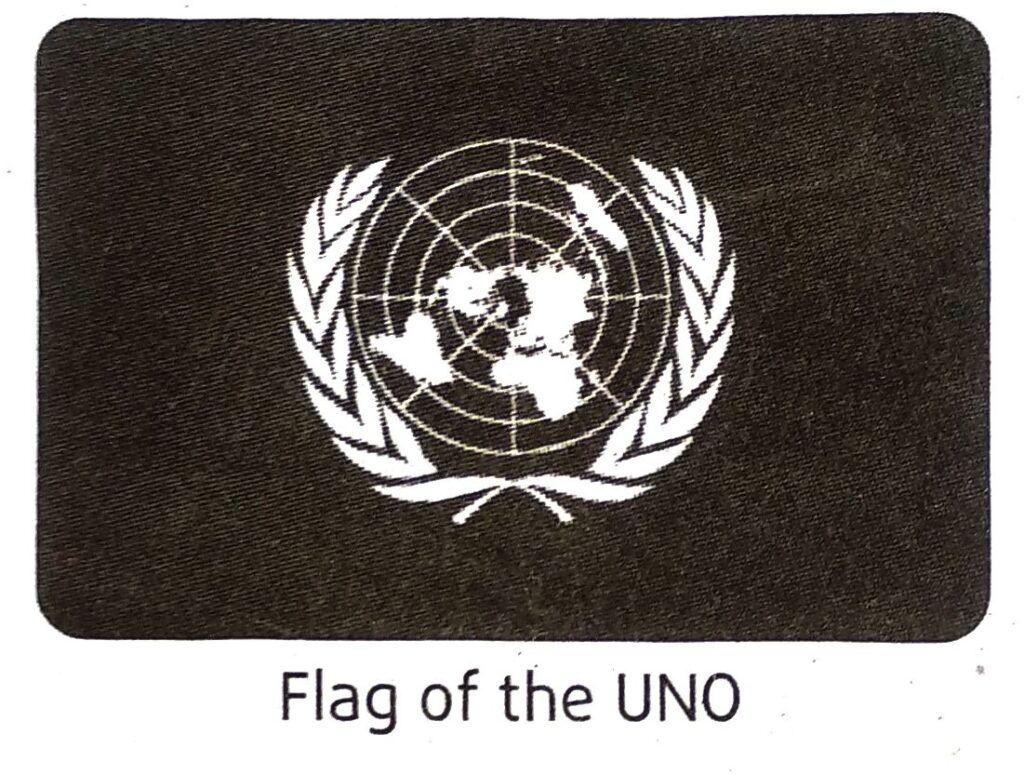
[1] to maintain world peace, prevent armed conflict among nations, promote peaceful settlement of international disputes and to remove international tension; [2] to promote education, culture and health of mankind and to promote economic condition of the poor and underdeveloped nations.
3 What is the UN Charter ?
Ans. Between April and June 1945 representatives of 50 nations who were directly or indirectly involved in the war against the Axis Powers (Germany, Italy and Japan) met at a conference at San Francisco. The Big Four (Britain, France, USA, Russia) dominated the conference and prepared a charter for world peace called the UN Charter.
4. What are the basic principles of UNO?
Ans. The basic principles of UNO are: [1] All the members, big or small, in order to enjoy the rights and benefits would sincerely carry out their duties as per the UNO Charter. [2] All members shall settle international disputes by peaceful means. [3] UNO would not interfere in the internal affairs of any country. [4] All members would enjoy the same sovereign status. [5] All members pledge to help. [6] All members would safeguard world peace.
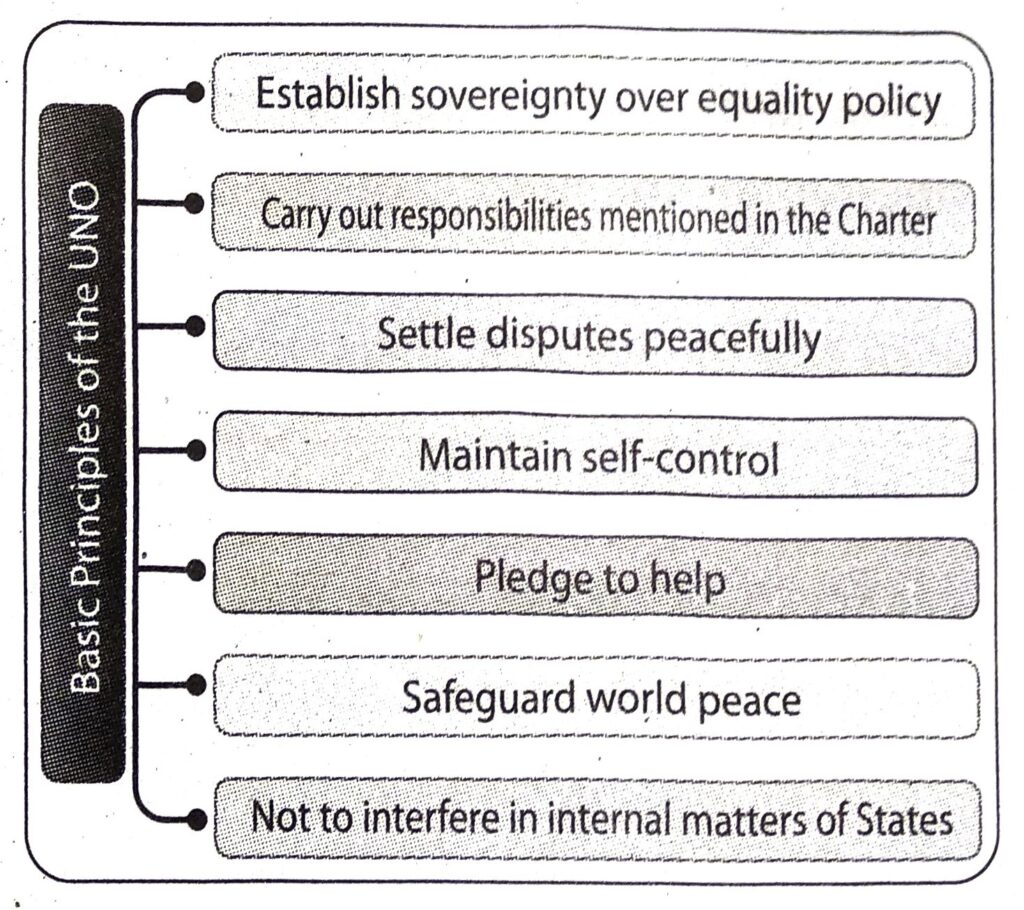
5. Write a note on membership of the UNO.
Ans. [1] The membership of the UNO is open to all peace loving nations of the world which accept the obligation of the UNO and are willing to carry out these obligations. [2] 51 states who signed the UN Charter are the original members of the UN. [3] Any member could be admitted in the UN on the recommendation of the Security Council and by a vote of assent by of the existing members of General Assembly. [4] America, England, France, Russia and China are the permanent members of the UN Security Council. [5] If member countries persistently violate the principles of the Charter they may be expelled by the General Assembly recommendation of the Security Council. on the
6. What is the function of the International Court of Justice ?
Ans. The function of the International Court of Justice is to solve the legal disputes that arise between different countries e.g. interpretation of treaties, application of principles of international law to a particular dispute or situation and settles issues of commensurate compensation for breach of international law etc. It also gives legal advice to the Security Council and the General Assembly.
7. What is FAO and WHO ?
Ans. FAO and WHO are two specialised agencies of the Economic and Social Council. FAO is Food and Agricultural Organisation and WHO is World Health Organisation.
Know More
The UN’s World Food Programme was awarded the Nobel Peace Prize in 2020 for its effort to provide food assistance in areas of conflict, and to prevent the use of hunger as a weapon of war and conflict.
8. What are the six main organs of the UNO?
Ans. The six main organs of the United Nations organisation are: [1] The General Assembly, [2] The Security Council, [3] The Economic and Social Council, [4] The Trusteeship Council, [5] The International Court of Justice and [6] The Secretariat.
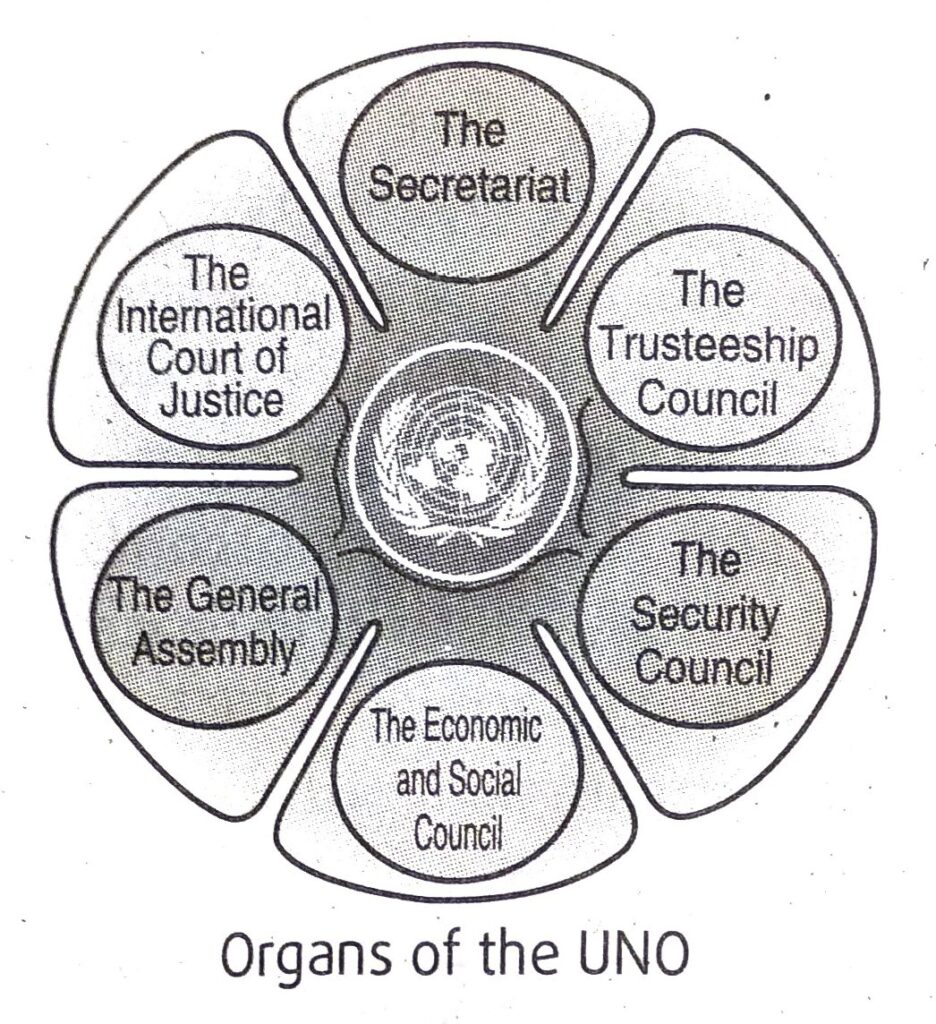
9. Why is 24 October celebrated as the United Nations Day?
Ans. Between April and June of 1945, representatives of 50 nations who were directly or indirectly involved in the war against the Axis Powers met at a conference led by Britain, France, USA and Russia at San Francisco and prepared a charter for world peace called the UN Charter. The Charter became officially effective from 24 October. So this day is celebrated as the United Nations Day.
10. What is ‘Veto’?
Ans. The foremost responsibility of the Security Council is the maintenance of international peace and security. All the five permanent members of the Security Council (USA, USSR, UK, France and China) must agree on all important issues. A negative vote by any one permanent member is called a ‘Veto’. If the Veto is exercised, then the proposal or resolution is considered not passed. So on this issue the Security Council cannot take any action.
11. What are the different specialised agencies of the Economic and Social Council?
Ans. The different specialised agencies of the Economic and Social Council are: [1] ILO (International Labour Organisation), [2] UNESCO (United Nations Educational Scientific and Cultural Organisation), [3] WHO (World Health Organisation), [4] FAO (Food and Agricultural Organisation), [5] IMF (International Monetary Fund)
12. What is the composition of the General Assembly?
Ans. The General Assembly of the UNO consists of all member states of the United Nations Organisation. Each member state can send five representatives to the session of the General Assembly. The total strength of the UN General Assembly is now 193.
13. What is the composition of the Security Council of the United Nations Organisation?
Or, Write a note on the membership of the Security Council.
Ans. The most important organ of the UNO is the Security Council. There are two types of members in the Council-permanent and non-permanent. Five permanent members are the USA, USSR, UK, France and China. The ten nonpermanent members are elected by the General Assembly for a term of two years.
14. Name the permanent members of the We Security Council of the UNO.
Ans. The permanent members of the Security Council of the UNO are: [1] America, [2] England, [3] France, [4] Soviet Russia, [5] China.
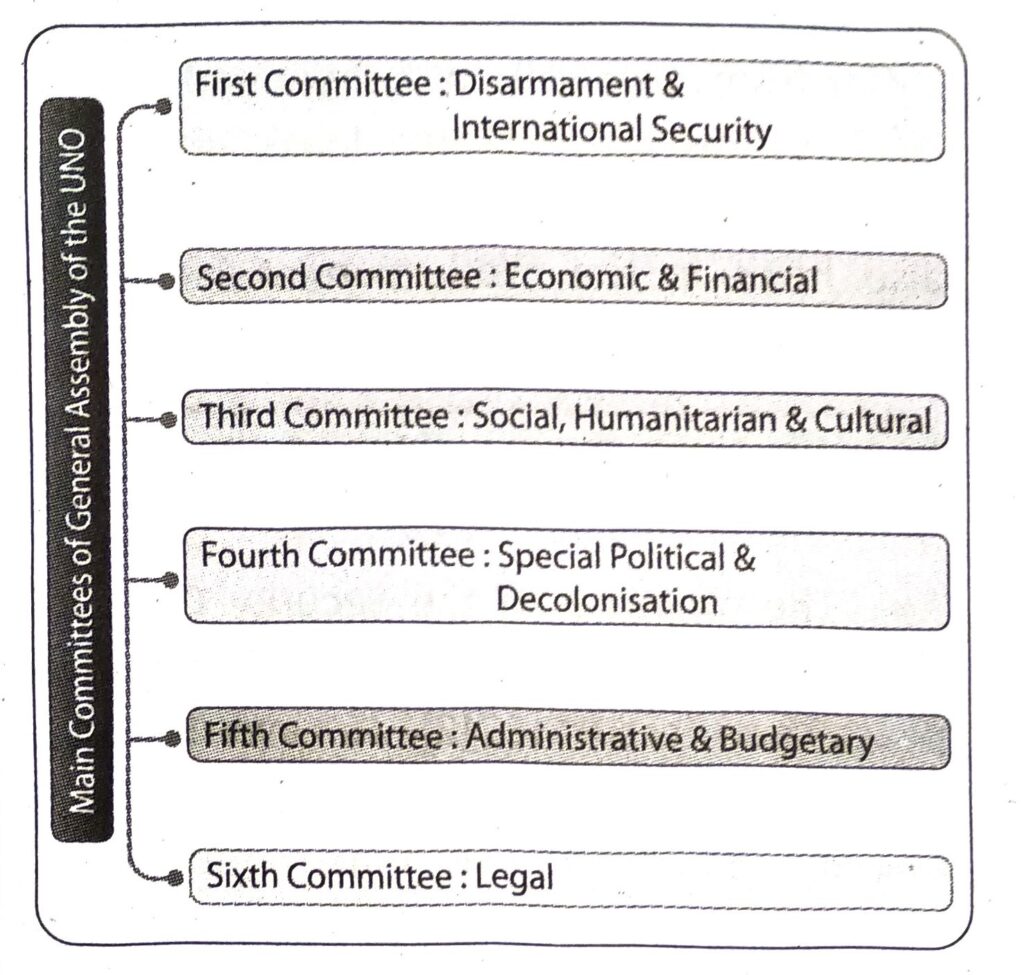
15. What are the functions of UNESCO ?
Ans. The UNESCO deals with the issues of economic and social welfare and works for preservation of human rights across the globe. This body fights against illiteracy and devotes itself to protection of health, spread of education, improvement of the standard of living of the people. The task before UNESCO includes education, social science, natural science, mass communication, cultural activities and relief services.
16. What are the functions of WHO ?
Ans. WHO (World Health Organisation) organises campaign throughout the world against diseases such as pox, plague, small pox, cholera and others. It undertakes medical research to find out the causes of diseases, improve vaccines and train medical research and aid workers.
17. What are the functions of UNICEF?
Ans. The function of the UNICEF is to help the member countries improve the health condition of their children and to save the lives of sick or starving children in the world who suffer from malnutrition, hunger and different kinds of diseases. It also looks after social welfare and vocational training of children. It also helps in the production of inexpensive books for children.
18. What are the functions of the Security Council of the UNO?
Ans. The functions of the Security Council of the UNO are: [1] to maintain international peace and security, [2] to investigate all disputes and recommends ways and means for peaceful settlement, [3] to take action against a defaulting state and ask its members to send military forces in order to control a dangerous situation.
19. What are the functions of the Economic and Social Council? nctions of the com
Ans. The functions of the Economic and Social Council (ECOSOC), a non-political organ of the UNO are: [1] to promote economic and social advancement of all people, [2] planning of economic development, financial and technical assistance to underdeveloped countries, industrialisation of backward countries, improvement of education and aid to the world’s needy children, [3] to appoint special committees from time to time to study specific problems.
20. Write a short note on International Labour Organisation (ILO).
Ans. The headquarters of the International Labour Organisation was established at Geneva. All the member-states were also members of the International Labour Organisation. The main aim behind its establishment was to improve the condition of the labourers in different countries.
21. Write a note on the function of the Trusteeship Council.
Ans. After World War II, some underdeveloped countries were placed under the supervision of the Trusteeship Council. The primary task of the Council is to look after economic, social, political and cultural development of these countries. An indirect function of the Trusteeship Council is to eliminate the possibility of rivalry among powerful nations of the world for exploitation of underdeveloped nations.
22. What is the function of the head of the Secretariat ?
Ans. The head of the Secretariat, the Secretary General, prepares an annual progress report of the UNO and places it before the General Assembly. He has the right to draw attention of the Security Council to any matter which in his opinion, may threaten international security.
23. When was the Yalta Conference held? Name the countries which took part in the Yalta Conference.
Ans. The Yalta Conference was held in 1945.
The countries which took part in the Yalta Conference were USA, Britain and Russia.
24. When and where was the Atlantic Charter signed ?
Ans. The Atlantic Charter was signed on 11 August 1941. Winston Churchill, the Prime Minister of Britain, and Franklin Roosevelt, President of USA met together on a warship called the ‘Prince of Wales’ in the Atlantic Ocean near Newfoundland and signed the Atlantic Charter.
25. What is the importance of the Atlantic Charter ?
Ans. The Atlantic Charter is important because it contained the aims and fundamental principles for the reconstruction of the post-Second World War. An indication to set up a world organisation for the preservation of peace in the world was given in this Charter. in this Charter the term ‘United Nations’ was first adopted.
26. Mention two limitations of the UFO. ?
Ans. [1] The first limitation of the UNO is that the right of absolute veto has been given to each of the ‘Big Five’ (USA, UK, France, China and Russia). The Big Powers have always on several occasions misused this right in their self interest. [2] UNO has not achieved ed success in gaining the cooperation of all the ‘Big Five’ at a time on the question of the enforcement of the decision of the Security Council with the help of an international army.
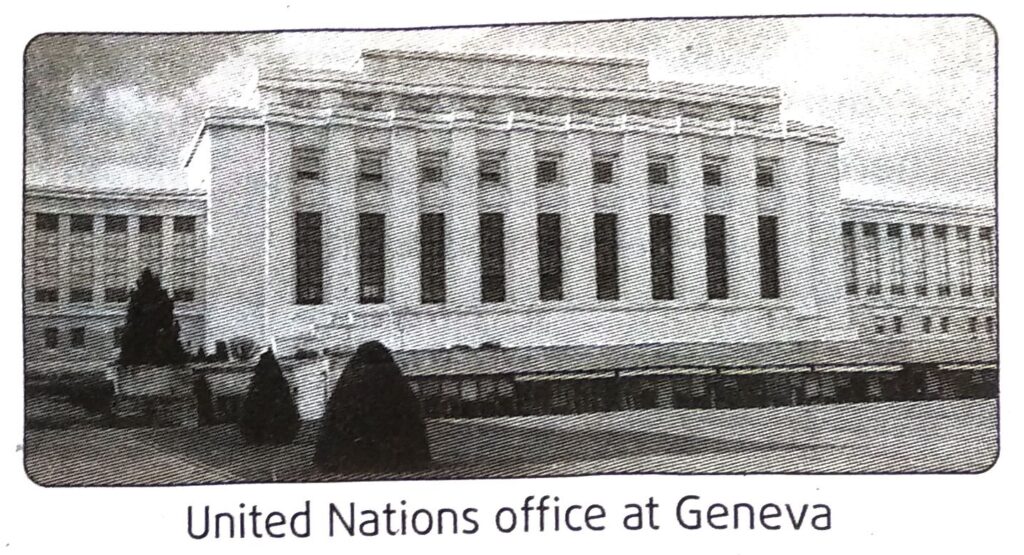
27. Give an account of the success and failure of the League of Nations.
Ans. The League of Nations utterly failed in its fundamental aim to prevent war and to maintain peace and order in the world on a permanent basis. The world had to witness again the Second World War in 1939 which proved the failure of the League. On the other hand, if we evaluate the work of the League of Nations we find that the League tried its best to solve political disputes and the controversies which arose among different countries. In addition to this, the League acted also in the TETOVNE social and humanitarian fields for the benefit of mankind .
Very Short Answer (VSA) Type Questions
Answer in one sentence
1. Who selected the name United Nations Organisation ?
Ans. The name United Nations Organisation was selected by the American President Franklin Roosevelt.
2. From where did Franklin Roosevelt select the name United Nations Organisation ?
Ans. Franklin Roosevelt selected the name United Nations Organisation from Lord Byron’s poem ‘The Childe Harold’s Pilgrimage’.
3. When was the UNO established and where ?
Ans. The UNO was first established on 24 October 1945, in New York, USA.
4. For how many years and by whom are the members of the Security Council elected ?
Ans. The members of the Security Council are elected for two years by the members of the General Assembly.
5. How are new members admitted in the UNO?
Ans. New members are admitted in the UNO on the recommendation of the Security Council and by a vote of assent by 2/3 of the existing members of General Assembly.
6. How many members are there in the Security Council of the UNO at present?
Ans. There are 15 members in the Security. Council of the UNO at present.
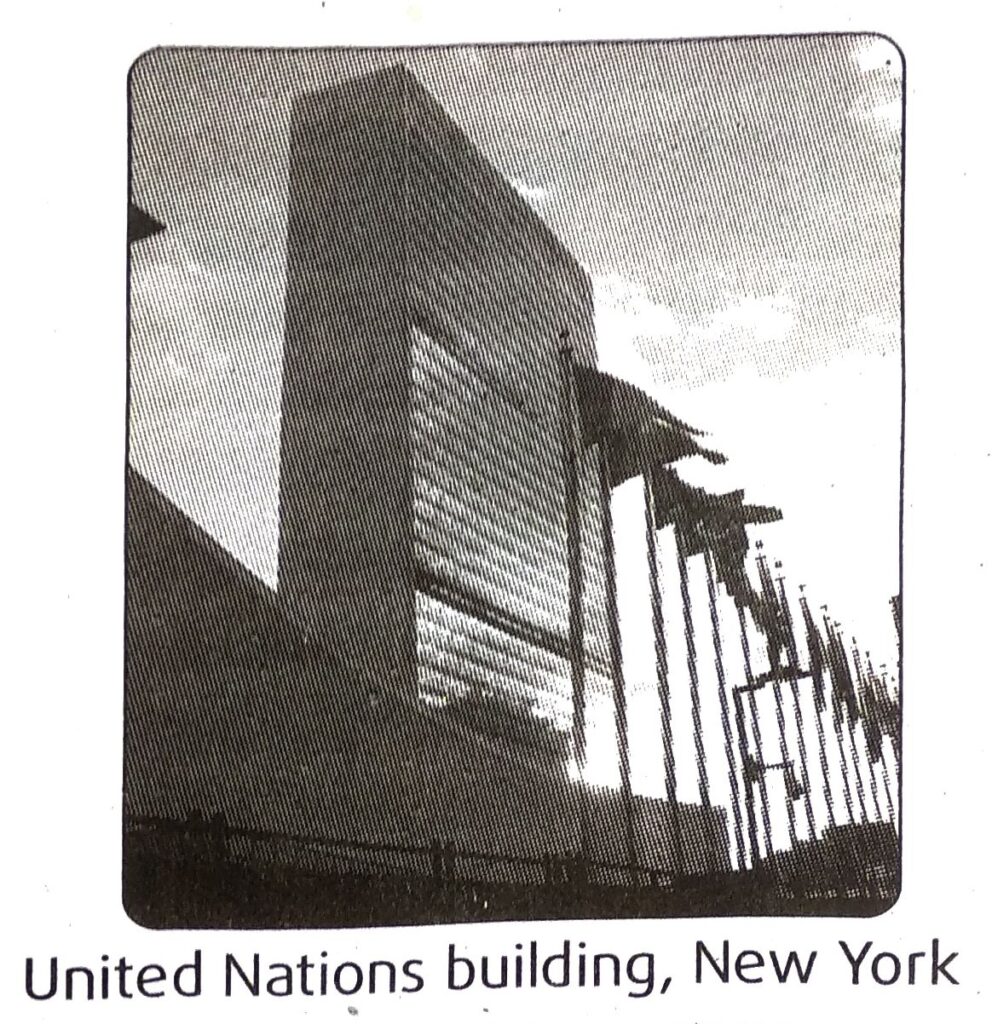
7. What is the seventh principle enumerated in the UN Charter ?
Ans. The seventh principle enumerated in the UN Charter is that UN would not interfere in matters strictly within the domestic jurisdiction of any state.
8. How many principles have been mentioned in the UN Charter?
Ans. Seven principles have been mentioned in the UN Charter.
9. How many charter members were there in the UNO?
Ans. There were 51 charter members in the UNO.
10. Which countries are the five members of the Security Council with the power of Veto?
Ans. The five members of the Security Council who have the power of Veto are USA, USSR, England, France and China.
11. What is the judicial organ of the United Nations?
Ans. The judicial organ of the United Nations is the International Court of Justice.
12. How many judges are there in the International Court of Justice?
Ans. There are 15 judges in the International Court of Justice.
13. How are the judges of the International Court of Justice elected?
Ans. The judges of the International Court of Justice are elected by the General Assembly and the Security Council.
14. Name two organisations under the Economic and Social Council.
Ans. The two organisations under the Economic and Social Council are UNESCO (United Nations Educational Scientific and Cultural Organisation) and FAO (Food and Agricultural Organisation).
15. What does UNICEF stand for?
Ans. UNICEF stands for United Nations International Children’s Emergency Fund.
16. Where is the headquarters of WHO?
Ans. The headquarters of WHO is in Geneva.
17. What does WHO stand for ?
Ans. WHO stands for World Health Organisation.
18. What does UNESCO stand for ?
Ans. UNESCO stands for United Nations Educational, Scientific and Cultural Organisation.
19. What is the composition of the Trusteeship Council?
Ans. The Trusteeship Council is composed of the representatives of permanent members of Security Council, representatives of all those states which hold the administration of colonies and some representatives elected by the General Assembly.
20. How is the head of the Secretariat of UNO appointed?
Ans. The head of the Secretariat, the Secretary General, is appointed by the General Assembly on the recommendation of the Security Council.
21. Who is the present secretary general of UNO ?
Ans. The present secretary general of UNO is Antonio Guterres.
22. When and where was the United Nations Declaration signed?
Ans. On 1 January, 1942 the United Nations Declaration was signed in Washington.
23. Where is the headquarter of Food and Agriculture Organisation (FAO)?
Ans.The headquarter of Food and Agriculture Organisation is located in Rome.
Mark True or False
1. The UNO was established after the Second World War.
2. The headquarters of UNO is located in London.
3. The name of the executive authority of the UNO is the Security Council.
4. 24 October is celebrated as the ‘United Nations Day’.
5. The Economic and Social Council of the UN specifically works on economic, social, cultural and humanitarian problems.
6. Veto power is given only to 4 countries.
7. General Assembly of the UNO meats twice in a year.
8. The normal term of office of the UN Secretary General is 5 years.
9. The Secretary General is required to submit an, annual report on the work of the UN to the Security Council.
10. The headquarter of the International Court of Justice is located in Netherlands.
11. The term for the judges of the International Court of Justice is 9 years.
12. The headquarters of the World Health Organisation is in Washington.
13. Ramaswami Mudaliar signed the UN Charter for India.
14. Seven languages are recognized by UN.
Answers :
1. True , 2. False , 3. True, 4. True, 5. True, 6. False , 7. False , 8. True , 9. False , 10. True , 11. True , 12. False , 13. True , 14. False.
Fill in the blanks
1. The Second World War began in _________ (1937/1938/1939).
2. The UNO was founded in __________(1945/1946/1947).
3. The UNO was established in __________(New York, USA/London, Britain/Paris, France).
4. The International Court of Justice was established in _____(the Hague/London/ New York).
5. The Headquarter of UNICEF is in ________ (New York/London/Paris).
6. UN Secretary General heads the __________ (General Assembly/Security Council/ Secretariat) of the United Nations Organisation.
7. The General Assembly of the United Nations meets in a regular session __________ (once/twice/once in two years) in a year.
8. ________(USA/UK/Spain) is not a permanent member of the UN Security Council.
9. ________(General Assembly/Security Council/ UNESCO) is not the main organ of the UNO.
10. World Disarmament Conference was convened in _________ (1929-30/1932-33/193334).
11. In the Yalta Conference Russia was represented by _________(Lenin/Trotsky/ Stalin).
12. The UN Charter was amended in __________ (1949/1950/1951) during the Korean War.
13. The __________ (Security Council/the General Assembly/the Economic and Social Council) is the heart and perhaps the brain of the UNO.
Answers :
1. 1939
2. 1945
3. New York, USA
4. the Hague
5. New York
6. Secretariat
7. once
8. Spain
9. UNESCO
10. 1932-33
11. Stalin
12. 1950
13. Security Council
Choose the best explanation
1. Statement: The UNO has failed to establish world peace.
Explanation (A) : The army of UNO is weak.
Explanation (B) : It is inactive in maintaining world peace.
Explanation (C) : Right to veto at the disposal of five countires.
2. Statement: 24 October is celebrated as the United Nations Day.
Explanation (A) : The United Nations first session was held on this day.
Explanation (B) : The UN charter became officially effective from this day.
Explanation (C) : The official logo of the United Nations was unveiled on this day.
Answers :
1. Explanation (C)
2. Explanation (B)
Multiple Choice Questions (MCQ)
1. The UNO was founded on –
A. 24 October 1945
B. 29 October 1946
C. 24 October 1947
D. 25 October 1946
Ans. A
2. The number of judges in the International Court of Justice is –
A.15
B. 16
C. 17
D. 18
Ans. A
3. The UN Charter was finalised and became effective –
A. San Francisco, 24 October, 1945
B. Paris, 5 March, 1944
C. Yalta, 2 February, 1945
D. None of these
Ans. A
4. Trygve Lie, the first Secretary General of UNO, was from –
A. USA
B. Korea
C. Norway
D. France
Ans. C
5. The term of office of a judge of the International Court of Justice is –
A. 6 years
B. 7 years
C. 8 years
D. 9 years
Ans. D
6. The number of principal organs of the United Nations is –
A. 6
B. 5
C. 4
D. 3
Ans. A
7. The following is not associated with UN –
A. ILO
B. WHO
C OASEAN (Association for South East Asian Nations)
D. IMF
Ans. C
8. Which of the following is not a chief organ of the UNO?
A. International Labour Organisation
B. Security Council
C. International Court of Justice
D. General Assembly
Ans. A
9. The full form of ILO is —
A. Internal Labour Organisation
B. International Labour Organisation
C. International Lawyers’ Organisation
D. Internal Labour Office
Ans. B
10. UNO was established after –
A. Russo-Japanese war
B. First World War
C. Second World War
D. The Battle of Waterloo
Ans. C
11. Atlantic Charter was declared by –
A. Roosevelt and Churchill
B. Churchill and Stalin
C. Jawaharlal Nehru and Stalin
D. None of the above
Ans. A
12. The UN Charter was ratified in 1945 by –
A. 25 nations
B. 51 nations
C. 33 nations
D. 37 nations
Ans. B
Follow on Facebook page – Click Here
Google News join in – Click Here
Read More Asia News – Click Here
Read More Sports News – Click Here
Read More Crypto News – Click Here